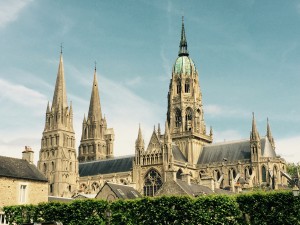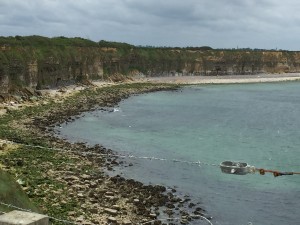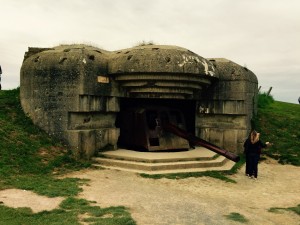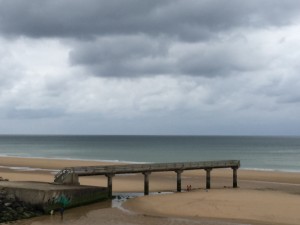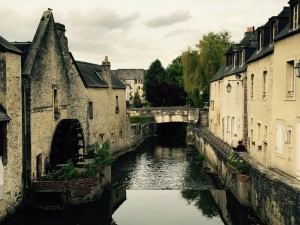Comfort Me with Apples
(Titled lifted from Ruth Reichl’s book of the same name.)
The moment the man said, “In Normandy, we butter our bread before slathering on the cheese,” I knew I was in the right place. The heavy cream and Calvados-laden dishes only confirmed it. But even though I love butter and can eat my share of Camembert, I was actually in Normandy for another reason—to experience D-Day exactly where it happened.
As a World War II history buff, who spent a university year studying the subject in Germany—on the ground, in the camps, and with the people who lived it from the other side, I had already covered a lot of central Europe. However, still missing from my education were the beaches where on June 6, 1944 Allied troops landed and changed the fate of the world.
I launched my tour from Bayeux, one of the few Norman towns that wasn’t destroyed during the war. Home to the Bayeux tapestries, famous for depicting the Norman conquest of 1066, the town is full of present day charm and medieval alleyways. Bayeux was saved because it was located at D-Day +1—military lingo meaning the town was secured one day after landing, and luckily before 11,590 bombers decimated the area.
Since it was a few days before the June anniversary, I had expected to find warm weather. Instead, it was a drizzly 52 degrees F—the exact same temperature as in 1944. Not having packed a coat, boots, or even an umbrella for summer, I tried to ignore the biting wind that eventually lifted me off the ground, or at least it felt like it did for a brief second. The sensation made me retreat from the jagged cliff at Pointe-du-Hoc, next to Utah Beach. The same cliff that troops trained an entire year to scale in order to overtake the German encampment.
I was in awe of nature, but more in awe of what the soldiers endured, and that’s without gunfire. On the verge of feeling cold and miserable, I reminded myself that it wasn’t so bad, for I had a warm bed to sleep in that night. They had not.
I soon learned that my horrid wind was only half the strength of their horrid wind; the white tipped seas only half as rough. This put everything into perspective, much more than the ruined German artillery bunkers or the barren, pebbled beaches.
D-Day was originally scheduled for June 5th. At midnight, soldiers were given a full breakfast and sent off. The sea was so rough that when the first troops became violently seasick, they turned back and the mission was postponed. In the meantime, they were given something to calm their stomachs, but it only made them worse. Twenty-four hours later, they set off again–cold, sick and scared, not to death, but of death (90% of the first wave was killed).
As we walked along the beach and later into green, grassy fields surrounded by apple trees, our guide shared stories that he had learned from GIs who had come to retrace their steps in battle. He’d listened to their intimately detailed accounts and over time put together a vivid portrayal of events, giving me, at least, an insight hard to find in books.
Looking at the pebbles that cover Omaha beach, I now see the destruction they caused when mortar fire lifted them into the air. They returned as heavy stones pelting men on all sides, sometimes causing severe injury.
Not far away, standing near centuries-old farmhouses, I imaged what that morning would have been like for the farmer who had awoken his entire life to an empty sea, only to find it filled with more than 5000 vessels and 156,000 men rushing toward him. In these boats that clogged the shores, captains shouted to their distressed troops, “We’re going to die either here, in this boat, or over there, on land. So, let’s at least try to make a difference.”
Paratroopers also descended into Normandy that night. If they landed safely (40% did not), they had to quickly unstrap their parachutes, hide them and then search their unit. They located each other with bird calls. One paratrooper was caught on a church steeple in the town of Sainte Mere Eglise. His presence shocked the town, up before dawn, helping to extinguish a fire. It was their sign, before the heavy artillery began, that something big was coming. The paratrooper hung in the air for hours, until the Germans cut him down. He was taken prisoner, but not for long—the town was liberated that first afternoon, after the Allies managed to construct landing bridges to unload tanks on the beaches. It was considered one of the greatest engineering feats of the time.
On that day, I also learned that Calvados, the local apple brandy that warms the body so well, became a problem for the troops. When grateful farmers wholeheartedly offered incoming soldiers sips of brandy, they quickly indulged. Who could blame them? They were hungry and cold and welcomed the comfort. However, drunkenness ensued. By D-Day +1 Calvados was off-limits.
Reading history in books is one thing, but feeling the wind whip in your rain-dripped face while standing on hallowed ground is another. At the end of the day, I, too, went searching for the comfort of apples.
Tags: Bayeux, Bayeux tapestries, Calvados forbidden in WWII, Calvados in Normandy, D-Day beaches, delicious expeditions, kris rudolph, Normandy, Normandy beaches


